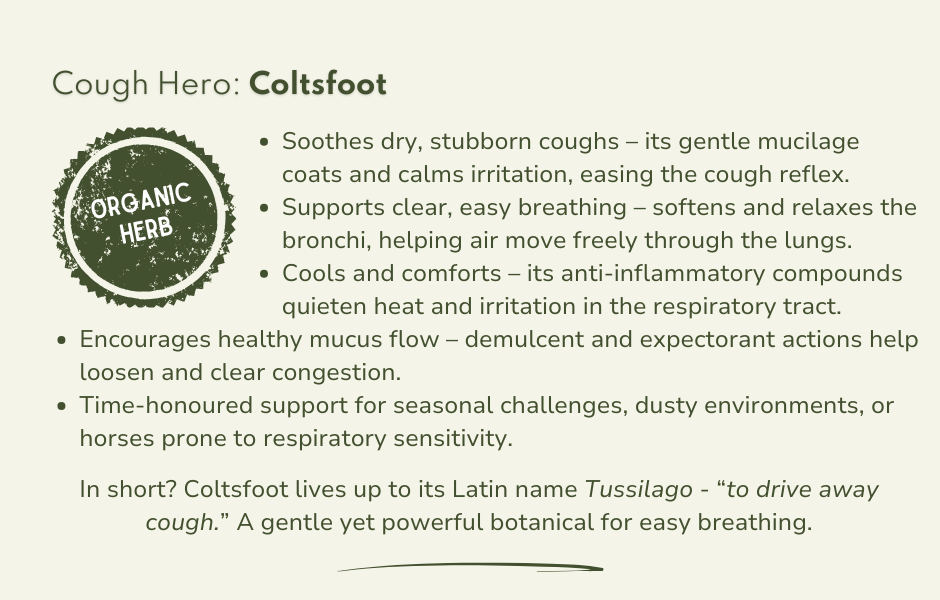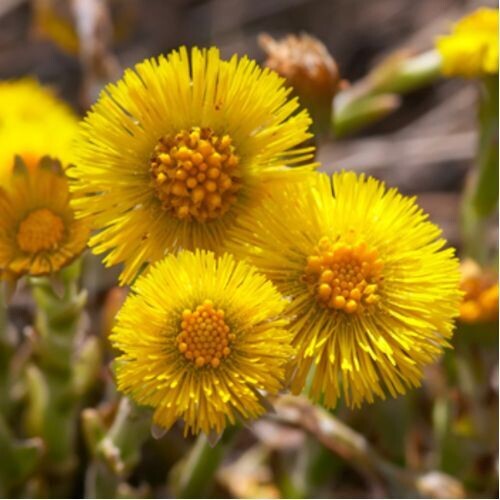COLTSFOOT (Tussilago farfara) *Organic herb for horses - cough-calmer, breath-soother, lung-strengthener
Benefits of Coltsfoot for Horses
Once the emblem of apothecaries across Europe, Coltsfoot remains one of nature’s finest respiratory botanicals.
With its soothing, demulcent qualities, it helps calm dry and stubborn coughs, eases breathing, and supports lung comfort through seasonal challenges.
Please note this is a nutritional, functional horse food supplement and not veterinary medicine. See Dr Kellon's Horse Sense - Nutrition is not 'Alternative' Therapy for more information.

Find Organic Coltsfoot in the EquiNatural range
You'll also find Coltsfoot in our KoffTonic tincture blend - cough-clearing, airway-soothing, and breath-balancing.
Composition & Feed Guide
💧Organic Coltsfoot Leaf Tincture
Our human-grade, certified organic tinctures give you a ready-to-absorb potent source of phytonutrients at the highest-strength available, for immediate absorption straight into the bloodstream and to the body’s cells.
- Tussilago farfara, Leaf
- Infused 1:3 35%
- Wild harvested
~ Feed Guide - 6ml/100kg bodyweight, daily in feed.
🌿Organic Dried Coltsfoot Leaf
Grown, harvested and dried without the use of agri-chemicals, non-irradiated and GMO free - see our Quality page for Quality Management & Certification Documents.
- Tussilago farfara, Leaf
- Wild harvested
- Origin Poland
~ Feed Guide - 5g/100kg bodyweight per day, i.e. 25g for a 500kg horse.
Functional Nutritional Value
Constituents: Flowers: mucilage; flavonoids (rutin, carotene); taraxanathin; pyrrolizidine alkaloids (senkirkine, senecionine, tussilagine). Leaves: mucilage; flavonols (quercetin, kaempferol and their glycosides); tannins; inulin; phytosterols (sitosterol, stigmasterol, taraxasterol); sesquiterpene (tussilagone); zinc.
Footnotes
- Laboratory tested for identification and compliance to the British and European Pharmacopoeia standards.
- Human grade.
- Please be aware that if you're purchasing our dried botanicals for human use, our dried range is cut to appropriate sizes for feeding to horses.
- ♻️ Eco Note: Our packaging is recyclable and refillable.
- 🧊 Storage Tip: Keep cool and dry.
Clinical Considerations
Advisories
Coltsfoot is generally considered a safe and gentle botanical for supporting respiratory comfort in horses when used at recommended levels
- As the leaf can contain trace amounts of unsaturated pyrrolizidine alkaloids (PAs), ensure sourcing from reputable, tested suppliers (as with all EquiNatural herbs, stringent organic quality control practices and laboratory testing and compliance with British and European Pharmacopoeia standards apply)
Contraindications
- Not suitable for pregnant or nursing mares due to the presence of naturally occurring pyrrolizidine alkaloids.
- Avoid in horses with known liver disease or compromised hepatic function, as PAs are metabolised via the liver.
- Do not use in conjunction with other PA-containing herbs (e.g. comfrey or borage) without professional guidance.
Coltsfoot in History & Tradition
If you had stepped into an apothecary shop in the 17th or 18th century, you’d have recognised coltsfoot straight away - the golden flower was the emblem proudly painted on apothecary signs. Even today, many herbalists still use the coltsfoot bloom as a logo, a nod to its long-standing reputation as a healer of the lungs.
Its very name tells you what it does: Tussilago comes from tussis (“cough”) and ago (“to drive away”). For centuries, coltsfoot has been considered one of the finest cough herbs - a soothing, strengthening pulmonary tonic.
History and tradition
- The Romans valued it as a go-to for respiratory complaints.
- Herbalist Nicholas Culpeper praised its fresh leaves, juice, or syrup for easing “ a bad, dry cough, or wheezing and shortness of breath. ”
- Ancient Greeks and Romans even smoked the dried flowers to calm coughs (though we wouldn't recommended this today!).
- Like its relative elecampane, coltsfoot found its way into traditional cough sweets, boiled in honey or sugar syrup.
How it works
Coltsfoot is packed with mucilage, making it both soothing and protective for inflamed throats and lungs. Its actions include:
- Antitussive – calming stubborn, irritating coughs
- Expectorant – loosening and moving phlegm
- Demulcent – coating and soothing dry, inflamed tissue
- Anti-inflammatory – cooling inflamed airways and mucous membranes
- Anticatarrhal – easing catarrh and congestion
It’s particularly indicated for convulsive coughing fits - the sort that rack the chest and leave you exhausted.
Beyond the lungs
In Western herbalism, the leaves are noted for their high zinc content, which supports immune health and reduces mucosal inflammation. Coltsfoot has even been compared in its anti-inflammatory action to modern NSAIDs like indomethacin.
It’s also considered a mild diuretic, historically used for cystitis. And for the more adventurous - coltsfoot leaves have even been cooked as food: simmered with onion and potato into a soup, or steamed like spinach with butter.
Today, coltsfoot remains a cornerstone respiratory herb, especially in tincture form. Tincturing extracts up to 10 times more active constituents than a herbal tea, which is why it’s often chosen for formulas like cough blends and syrups.
NB. Hence why we only produce our KoffTonic
in tincture form to maximise the benefits and efficacy.
Coltsfoot continues to live up to its name - soothing coughs, easing the breath, and supporting the lungs with the same reliability that made it a healer’s emblem centuries ago.
© EquiNatural 2025. All content is original work protected under copyright, and may not be re-published, duplicated, or rewritten for commercial use without permission.



